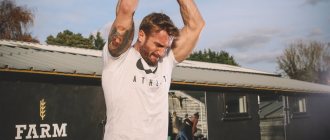Content
- 1 Swimming: the best training programs
- 2 Terminology of the training process
- 3 Tasks for the warm-up part of the workout 3.1 Series 1. Classic
- 3.2 Episode 2. Liberating
- 3.3 Series 3. Non-standard
- 3.4 Episode 4. Technical
- 3.5 Episode 5. Rhythmic
- 3.6 Episode 6. Smooth
- 4.1 Series 1. Classic
- 5.1 Series 1. Classic
- 6.1 Series 1. Classic
- 7.1 Series 1. Classic
- 8.1 Series 1. Classic
- 9.1 Series 1. Classic
- 10.1 Series 1. Classic
Warm-up video
Important! Before a competition, the period of time between warm-up and start should not exceed 5-10 minutes, otherwise the positive effect will disappear - you begin to cool down, your heart rate decreases, and the feeling of stiffness returns. It is not always possible to calculate the time correctly or have the opportunity to warm up in the water. In this case, you need to do a basic warm-up 60-30 minutes in advance and another short one before the start. The warm-up itself should be much shorter and less intense than we usually do during training.
Thus, warming up before swimming is aimed at working out the main muscles involved in the swimming process. This is not only physical, but also mental preparation before training, allowing you to show your maximum capabilities. After all, skills brought to automatism will leave no room for excitement! Swim correctly and avoid the most common mistakes!
Swimming: the best training programs[edit | edit code]
Lesson scheme
In order to create a training series, select task options from this application. We offer representatives of each of the six categories of swimmers special exercises for different stages of the training process. They include:
- warm-up tasks;
- lead-in tasks;
- tasks for practicing technical skills;
- stimulating tasks (tasks at Critical Swimming Speed (CSS));
- endurance challenges (suitable for triathletes preparing to compete in Ironman races and open water swimmers);
- sprint tasks;
- tasks for practicing skills in open water;
- recovery tasks.
The tasks are combined into series to take into account the individual characteristics of swimmers.
- Classic series (good for Arnie).
- Liberating series (suitable for “bambino”).
- Innovative series (well suited for “drummers”),
- Technical series (suitable for gliders).
- Rhythmic series (well suited for swingists).
- Smooth series (pay attention to “smoothies”).
Choose a task that suits your swimming style and mood, and “mix” it with other tasks, building your own workout. Endurance tasks need to be considered separately, since they themselves are already training series, but from all the other exercises you need to create a full-fledged workout. Usually it consists of several required parts.
- Warm-up part.
- Leading part.
- The main part of the training, for which you can choose series: for technique;
- sprint;
- KSP;
- practicing skills in open water.
You can make over 5000 different combinations!
Why do you need a warm-up?
The importance of warming up before swimming cannot be overestimated. Its implementation cannot be ignored, since the effectiveness of training or results in competitions directly depends on preliminary preparation. For amateur or professional swimming to be beneficial, it is necessary to approach the training process consistently.
So, proper warm-up is necessary for:
- warming up muscles, increasing joint flexibility and ligament elasticity. This allows you to improve your sense of water, overall coordination, and easily vary your swimming speed.
- preparation of the cardiovascular system. Intense blood circulation and increased heart beats make it possible to get fully involved in work even at the strata
- conservation of strength. It has been proven that a swimmer who pays sufficient attention to preliminary exercises reduces energy costs by 30
- avoiding injuries - reducing the risk of muscle tears and sprains
- psychological preparation – allows you to focus on the upcoming training or competition, repeat the elements you have completed and tune in to the result
- Relieving hypertonicity of the main muscle groups
Thus, preliminary physical exercises are the key to productive training and success in competition. A proper warm-up allows you to activate the body’s internal reserves and mentally prepare.
Terminology of the training process[edit | edit code]
We will use abbreviations in the description of tasks and series. Their list is given below.
| v/s- | coordinated freestyle swimming |
| "include"- | it is assumed that there is a certain distance, broken into two (or more) parts, which should be swam continuously, i.e. 25m defined event / 25m freestyle |
| int.— | you need to swim very intensely, in other words, quickly |
| R- | swimming in a certain mode: for example, P = 1:00 (60 s). This means that you must start each segment one minute (60 seconds) after starting the previous segment, i.e. if the mode was set to a distance of 50 m, which you swim in 45 seconds, then you will have 15 seconds left to rest before the next swim |
| usk. 1-4 — | means acceleration on each of the four segments defined in the task. Swim each subsequent segment faster than the previous one, usually this is done in such a way that the last segment is swam at the threshold speed |
| PV- | timed swimming, i.e. swimming over a certain distance with time control |
| HP- | swimming on hands with a bun. Using a knob held between your legs makes it easier to concentrate on practicing your strokes and/or rotating your body. Place the bun as high as possible in the groin area. In tasks with a kolobashka, you can, if desired, use paddles and ropes |
| Heart rate- | heart rate, pulse, measured in beats per minute |
| flippers- | swimming with fins. This involves the use of fins to perform one or another part of the task. |
| + xx s- | a mandatory rest pause of xx s between each part of the task, regardless of what speed was achieved |
| breathing: 3 degrees / 5g.- | inhale after 3 or 5 strokes |
| KSP- | critical swimming speed, determined in time trials at distances of 400 m and 200 m, see chapter 27 |
| KSP ±8 s — | used in the series to indicate greater or lesser speed than KSP. A distance of 100 m is assumed unless otherwise stated |
| TT- | torpedo push. Pushing off from the wall of the pool, while the body should be in a streamlined position: arms extended forward behind the head |
| 3 x (4 x 100 m) - | three series of four segments, each of which is 100 meters, usually all segments in three series are identical |
| ↑/↓ | swimming two segments (there and back). You swim a distance from one end of the pool to the other, completing the task assigned to you (for example, an exercise), and then return, completing another task (for example, just swimming high-speed) |
| PP- | swimming in a straight line. Continuous freestyle swimming, straight |
| KP- | medley swimming. Combined swimming style in the following sequence: butterfly, backstroke, breaststroke, freestyle |
| Legs on the side (to be specified, on the left or right side) - | kicks are performed on the side, with the chest facing one wall of the pool and the back facing the other. The upper hand should remain on the hip, the lower, leading hand should be stretched forward, the ear pressed to the shoulder of the leading hand |
| Harnesses - | you can use an old inner tube from a motorcycle or car, are designed to pull your ankles together to improve muscle control while working to increase your stroke rate |
Warm-up on land for swimmers
The main goal that warming up on land before swimming allows you to achieve is to warm up the body before directly immersing yourself in the water. You should always start from the upper body, gradually working your way up to your feet. On land, all exercises should be performed slowly and smoothly. You need to start with simpler swings, gradually moving on to more complex rotational exercises, increasing the intensity and amplitude.
You should move on to working the next section only if the previous muscle group has been fully warmed up. Evidence of this is an increase in their elasticity and mobility. A properly warmed muscle allows you to do things that were difficult or brought significant discomfort at the beginning of the workout.
Basic dry warm-up exercises:
- Walking turns into running. Jumping on your toes on the side. Duration - about two minutes. Helps warm up the body, preparing it for further stress.
- Working out the neck - turning your head in different directions. This way the cervical vertebrae fall into place.
- Wrists - scrolling the hands in one direction and then in the opposite direction.
- Arms – rotation of the arms at the elbow joints.
- Shoulders - swing your arms forward and back. Allows you to relieve stiffness and tension.
- Back – increasing flexibility through lateral bending and rotation.
- Hip department – rotation of the pelvis.
- Legs – knee rotation, squatting.
- Ankle area - rotation of the leg in the ankle joint area, resting the toe on the floor or holding it in the air.
To finish, you can perform stretching exercises, both static and dynamic.
Important! Increased flexibility helps lengthen muscle fibers, which increases endurance and strength.
Tasks for the warm-up part of the workout[edit | edit code]
Simple tasks that gradually increase your heart rate.
Episode 1. Classic[edit | edit code]
Target
: Start your workout in a good mood by doing simple exercises.
Tasks
400 m h/s, easy, follow smooth exhalation and bilateral breathing + 30 s
300m HP with bob, ensure good body rotation + 20s
200 m fins ↑ “Broken Arrow” ↓free v/s + 15 s
100 m a/s, smooth and calm
Full distance
1000 m
Episode 2. Liberating[edit | edit code]
Target
Use fins to move smoothly, without tension, to the main part of the workout.
Tasks
2 times 200 m with long fins, smooth footwork, easy breathing + 20 s
2 x 100 m fins ↑6/1/6 ↓v/s + 15 s
2 x 50 m h/s, easy, relaxed + 10 s
Full distance
700 m
Episode 3. Non-standard[edit | edit code]
Target
The joy of life in all its diversity!
Tasks
3 times
Full distance
900 m
Option 1
- 100 m a/s, easy + 10 s
- 2 x 50 m + 10s HP - good grip
- 4 x 25 m + 5s h/s: odd - fast, even - easy
Option 2
fins, breathing: 5 gr. (v/s)
TT, alternating push-off on the chest with push-off on the back
HP with kolobashka, breathing: 1) 3 g.; 2) 5 g; 3) 7 gr.; 4) 3 gr.
Option 3
V/s, calmly and smoothly
fins: 25 m “Shoulder taps” 125 m h/s
V/s - gradual acceleration
Episode 4. Technical[edit | edit code]
Target
Development of coordination of movements and “sense of water”.
Tasks
5 x 200 m + 20 s
- h/s, breathing: 25 m left + 25 m right + 50 m bilateral
- fins ↑6/3/6 — ↓v/s
- h/s, breathing: 25 m left + 25 m right + 50 m bilateral
- HP: 15 m Rowing No. 1 + 85 m h/s
- v/s - at a relaxed pace, calm and relaxed
Full distance
1000 m
Episode 5. Rhythmic[edit | edit code]
Target
Warm-up for more experienced swimmers.
Tasks
2 x 500 m + 30 s
- in coordination - monitor breathing and smoothness of the stroke; constantly maintain an optimal reasonable pace
- HP - in the first and last 200 m = bun and tourniquet;
average 100 m = harnesses only
Full distance
1000 m
Episode 6. Smooth[edit | edit code]
Target
Learn to monitor the rhythm and coordination of breathing.
Tasks
200 m easy h/s - bilateral breathing
200 m HP - respiration: 5 gr.
200 m fins — ↑25 m Unco left +1 25 m h/s ↓25 m Unco right +25 m h/s
200 m HP - alternate sides for breathing every 25 m
200 m easy h/s - bilateral breathing
Recovery part of training[edit | edit code]
Speed table
Designed to gradually reduce the heart rate and remove metabolic products from the body.
Episode 1. Classic[edit | edit code]
Target
Relieve tension from the muscles of the shoulder girdle.
Tasks
100 m easy v/s
100m fins ↑"Broken Arrow" ↓v/s 100m easy HP, good body rotation
Full distance
300 m
Episode 2. Liberating[edit | edit code]
Target
Falling in love with the water, even stopping at the deep end of the pool every time to dive three times.
Exercise
200 m fins - strokes are long and smooth, watch your exhalation
Full distance
200 m
Episode 3. Non-standard[edit | edit code]
Target
Favorite series! The easiest way to relax!
Exercise
200 m with 2 x 50 m easily in/s
50m backstroke: arms - simultaneously, legs - breaststroke
Episode 4. Technical[edit | edit code]
Target
Try to control your speed while continuing to swim smoothly and consistently.
Exercise
6 x 50 m + 10 s, speed decreases by 2 s every 50 m, at the end very slowly
Full distance
300 m
Episode 5. Rhythmic[edit | edit code]
Target
Gradually reduce the stroke frequency, the movements remain smooth.
Exercise
6 x 50 m + 15 s, stroke rate decreases by 2 G/min every 50 m
Full distance
300 m
Episode 6. Smooth[edit | edit code]
Target
Finish your workout smoothly!
Tasks
100 m easy v/s
100 m HP
100 m high-quality fins
Full distance
300 m
Leg exercises
Circular movements of the knees
Place your knees together, place your palms on them and rotate your knees in a circle - in each direction 10 times.
Ankle
For crawl, butterfly and backstroke swimming, it is important that the ankle works in a wide amplitude - so that the foot is an extension of the leg (retracted back as wide as possible), and not a brake.
First, it is recommended to warm up by making circular movements of each foot in both directions .
Then we sit on our feet (on our knees) so that our feet are pressed under our buttocks and do the following:
- If you are not very stretched, just gently lean back .
- With a higher level of preparedness - lift your knees up:
Breaststroke stretch
We sit on our knees so that our feet are turned to the sides, then:
- At the initial level, we just sit in this position, trying to lower our buttocks to the floor .
- At an advanced level - carefully lie backas shown in the illustration:










